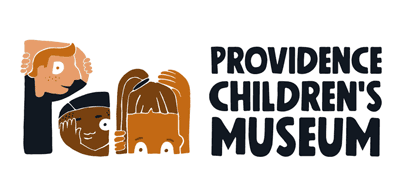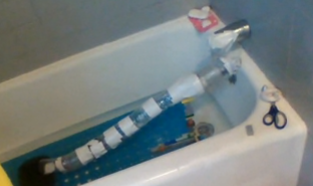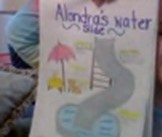Go With The Flow
Developed by Mary Nordby, PCM Play Intensive 2021
(FOCUS: K-2. 3-5, Science, Technology, Art, Engineering and Mathematics (STEAM), Design Thinking)
This K-5 STEM activity encourages children to explore the properties of water and use the steps of The Engineering Design Process: Ask, Imagine, Plan, Create, Test, and Improve.
“Go with the Flow” introduces students to the properties of water. They will utilize no-cost materials to work with their peers, families, and teachers to design and create a water slide that uses gravity to move a toy from the beginning of the slide to a pool at the end. Engineering design challenges such as this promote critical thinking skills, foster scientific reasoning, and encourage cooperation and perseverance.
Although it is not always evident, we use the Engineering Design Process when we solve problems every day.
Materials
- An assortment of household materials (Recommended examples include: cardboard tubes, straws, plastic wrap, foil, waxed paper, pipe cleaners, paper cups, cardboard, tape, glue )
- Basin or baking pan (to be used as the pool)
- A plastic cup
- A watering can or pitcher (optional)
- Small toys
- Paper
- Pencil
- 12 oz. water bottles (consider using these, cut lengthwise, as the main components of your slide. Your slide’s length will determine the number of bottles you need.)
- Utility knife (for adult use only), scissors
- Fun extra: color your water with blue or green food coloring. Ask an adult for help.
Student’s Job
Work with a partner to design and build a water slide that uses gravity to move a toy from the top of the slide into a pool.
- Plan a design for your water slide. What materials will you use? How will you keep the water contained in the slide? What will you use to support your slide. Sketch and label your design.
- Use found materials to design and build your water slide and its supporting structure.
- Place your basin or pan (the pool) on a flat surface, preferably outdoors. Place your slide in the basin or pan and the toy at the top of the slide.
- Pour water down the slide. Does your slide hold the water? Does the toy travel down the slide? What happens if you change the height from which you pour the water? Explore what happens if you change the amount of water. Is there a difference between pouring the water from a cup instead of a container with a spout, like a watering can or pitcher?
- Improve your design by using what you’ve learned. You may also go on a Learning Walk to see what others have done. Ask them what is and isn’t working for them and why.
Further Challenges:
Can you design a water slide that has at least one curve?
Teacher’s Job
Standards Alignment
NEXT GENERATION SCIENCE STANDARDS: ENGINEERING DESIGN
K-2-ETS1-1. Ask questions, make observations, and gather information about a situation people want to change to define a simple problem that can be solved through the development of a new or improved object or tool.
K-2-ETS1-2. Develop a simple sketch, drawing, or physical model to illustrate how the shape of an object helps it function as needed to solve a given problem.
NEXT GENERATION SCIENCE STANDARDS: EARTH AND HUMAN ACTIVITY
3-ESS3-1. Make a claim about the merit of a design solution that reduces the impacts of a weather-related hazard.
NEXT GENERATION SCIENCE STANDARDS: EARTH’S SYSTEM
2-ESS2-3. Obtain information to identify where water is found on Earth and that it can be solid or liquid.
COMMON CORE STATE STANDARDS.MATH.PRACTICE.MP1
Make sense of problems and persevere in solving them.
COMMON CORE STATE STANDARDS.MATH.PRACTICE.MP1
Reason abstractly and quantitatively.
COMMON CORE STATE STANDARDS.MATH.PRACTICE.MP3
Construct viable arguments and critique the reasoning of others.
Prepare/ Background Info
- Front load the students with a discussion about gravity. What is it? What do they know about it? Gravity – The force that makes objects fall toward the ground.
- Introduce and/or review the Engineering Design Process. (See resource links)
- Observe students as they work, looking for evidence of understanding. Do the children understand the relationship between the height of the slope and the rate of flow?
- Between the weight/size of the toy and its rate of travel?
- Are the students using the Engineering Design Process?
- Connect their learning to the real world by introducing them to a related career in STEM: Water Park Engineer
Extend/ Take it Further
Can you do anything to your slide to make the toy travel faster? Slower?
What happens if you use a different sized toy? Does it travel any faster or slower?
Why do you think that happens?
Does the amount of water you use make a difference in the speed of the toy?
Facilitation Strategies
Praise effort and perseverance. Encourage children to draw a plan before building their prototype. Ask open-ended questions – How did that happen? How does it work?
Play to Notice (Learning Framework)
Cooperative, independent, or parallel, engaged, problem-solving.
Are the students engaged in cooperative play, as evidenced by back and forth discussion, sharing of resources, and division of labor?
Content Matter to Notice
Gravity moves water downhill. The angle of the slope and the amount of water affect flow.
SEL to Notice
Decision making, perseverance, cooperation, respect, tolerance, self-management, self-awareness.
Are the students actively listening to each other’s Ideas? Are students able to resolve differences harmoniously? Is everyone participating?







0 Comments